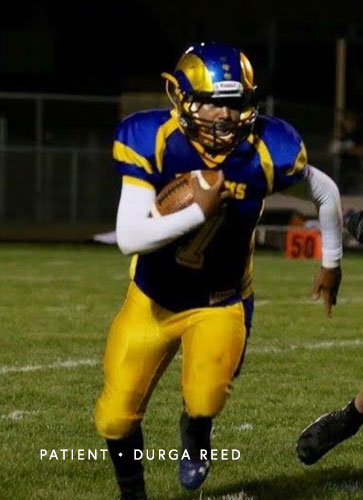Durga Reed
Scaphoid ORIF Nonunion
 I was playing football junior year of high school, and it happened right after a one-handed catch between the defensive back and myself. I came down hard and landed on my wrist backwards. Initially, I did not feel any huge rush of pain. Honestly, the pain went unnoticed for quite some time. Then, after 3 years of it continuing to have this dull pain and unable to reach full range of motion, I sought care. Over the next course of months, I saw 2 general practitioners who both gave the same treatment, ice, and activity modification, so I got a referral to see a specialist at The Steadman Clinic. I had known TSC from living in the Roaring Fork Valley. Every physical therapist and doctor I have worked with recommends The Steadman Clinic and Dr. Sachar. The decision to come to the clinic was a no-brainer.
I was playing football junior year of high school, and it happened right after a one-handed catch between the defensive back and myself. I came down hard and landed on my wrist backwards. Initially, I did not feel any huge rush of pain. Honestly, the pain went unnoticed for quite some time. Then, after 3 years of it continuing to have this dull pain and unable to reach full range of motion, I sought care. Over the next course of months, I saw 2 general practitioners who both gave the same treatment, ice, and activity modification, so I got a referral to see a specialist at The Steadman Clinic. I had known TSC from living in the Roaring Fork Valley. Every physical therapist and doctor I have worked with recommends The Steadman Clinic and Dr. Sachar. The decision to come to the clinic was a no-brainer.
Upon arriving to the clinic, Dr. Sachar’s team worked efficiently to diagnose and determine the best treatment option for me. The bone in my wrist was dead. I needed a new one and had to address the arthritis that developed. Surgery was the best and only option to get me back to doing what I love.
Surgery was a smooth, great experience. The nursing staff at the surgery center was fast, efficient, and very nice. Dr. Sachar’s team, including Jonathan Desillier, went to the extra extent to keep in touch with my family during the whole process. Recovery since has been incredible. I am doing physical therapy every week and feeling stronger every day. I would absolutely recommend Dr. Sachar. I think The Steadman Clinic is the top place in the country for specialist care, especially for athletes. Truly the best of the best at getting you back to doing what you enjoy. I am back to playing sports like basketball and look forward to hopefully playing football for University of Colorado Boulder this Fall 2021.
Clinical Background:
The scaphoid bone in the wrist is unique when discussing blood supply. Blood supply to the scaphoid is supplied via the distal aspect of the bone. Because the scaphoid spans both rows of carpal bones, the fracture frequently occurs at the waist of the scaphoid. Once the bone is fractured, blood supply to the proximal portion is no longer intact and the bone begins to degrade. This can lead to early onset arthritis, typically over the radial styloid and breakdown of the wrist joint.
To correct this problem, we begin by exposing the scaphoid and the fracture gap. Using a curette, the fracture gap is cleaned of debris to expose healthy bone. A measurement is made to determine the size of the bone graft needed to fill the void. In Durga, we went to his hip and took a piece of his iliac crest, measured to specifications, to fill the void in the scaphoid. Once the bone graft is sized and placed in the fracture gap, a canulated screw is drilled through the proximal portion, the bone graft, and the distal portion; compressing the bone as it threads through. Fluoroscopy is used throughout this procedure to perfect the outcome.
After surgery, the hard work begins. The first 6 weeks are spent in a forearm-based thumb spica cast; we also order a bone stimulator that is used throughout the day to stimulate bone growth by using micro-vibrations. Around 6 weeks, we transition to a custom molded splint and begin gentle range of motion, our priority at this point is healing of the scaphoid and restoring blood supply to the proximal pole. Sometimes we will obtain a CT scan to determine the healing of the fracture. Once the fracture is healed, aggressive therapy begins, maximizing your outcome.
At a Glance
Dr. Kavi Sachar
- Specializing in Hand, Wrist, & Elbow Surgery
- Board Certified Orthopedic & Hand Surgeon
- Consultant to the US Ski & Snowboard Team & Colorado Avalanche
- Learn more


